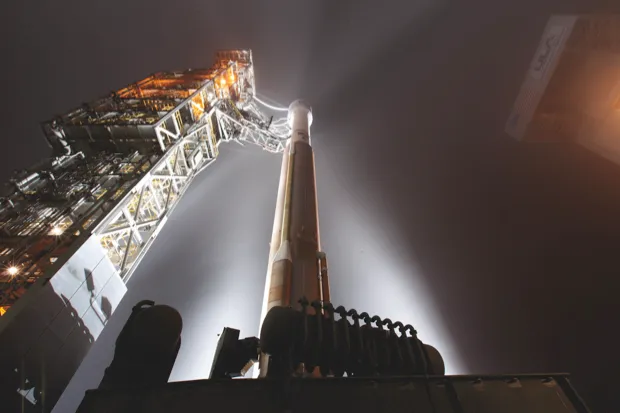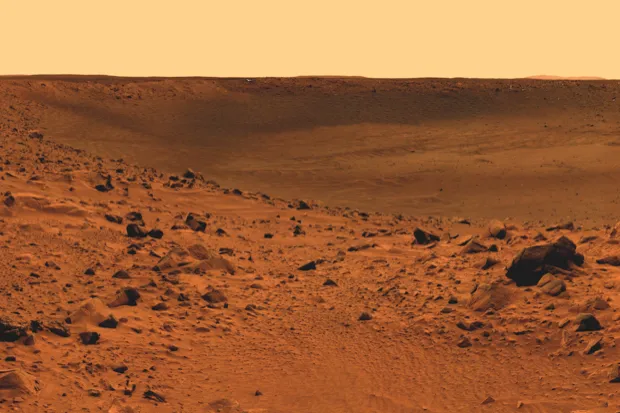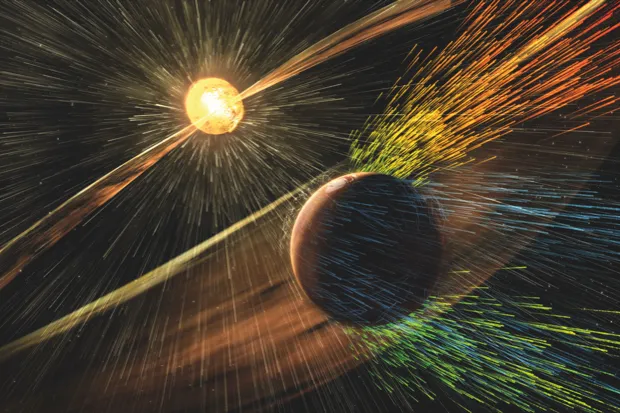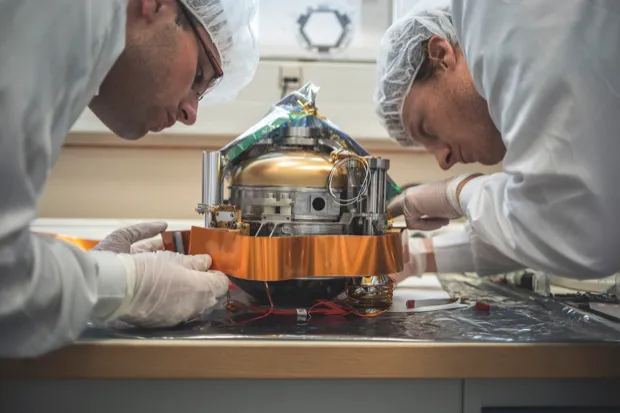Previous missions to Mars have been biased towards what’s happening on the surface. That’s no surprise given the menu of marvels on offer, such as sweeping sand dunes, soaring volcanoes and scintillating blue sunsets. We now know Mars’s outer facade so well that we have a better map of the Martian surface than we do of the ocean floor here on Earth. Yet it’s the deepest layers of a planet that really make it tick, and relatively little is known about the Red Planet’s interior.
Now, that’s all about to change thanks to a mission that has been long in the planning. “It was first proposed 25 years ago,” says Dr Suzanne Smrekar from NASA’s Jet Propulsion Laboratory in California. “We’re excited to finally be doing this.” Smrekar is the deputy principal investigator for the InSight mission. It was launched in May aboard an Atlas V-401 rocket from Vandenberg Air Force Base in California and is currently en route to the Red Planet. Due to touchdown on Mars on 26 November, close to NASA’s existing Curiosity rover, it will spend a minimum of one Martian year (nearly two Earth years) surveying deep beneath the famously ruddy dirt.

The goal of InSight is to give Mars’s interior the planetary equivalent of a full body health check. It will take its ‘pulse’ by carefully monitoring seismic activity (otherwise known as ‘Marsquakes’) and record its temperature by keeping track of the heat flow under the planet’s surface. That will help us understand how rocky planets, such as Earth and Mars, formed in the first place.
On Earth, most of these clues have been erased due to the action of our tectonic plates over billions of years. While seismic activity has been measured on the Moon, thanks to instruments left by the Apollo astronauts, it’s a much smaller world and it formed in a different way to the Solar System’s four rocky planets. Mars could hold secrets about how we came to be here in the first place, and InSight hopes to find them. “Mars is the perfect place for us to learn about terrestrial planet formation and evolution,” says Smrekar.
Touchdown on Mars
The lander itself is based on NASA’s Phoenix probe that touched down close to the Martian north pole in May 2008. By closely following a previous design, mission scientists have kept costs down. Since InSight will initially strike the Martian atmosphere at over 10,000 kilometres per hour, the craft has an outer shell that will shield the sensitive equipment from the heat generated by friction with Mars’s thin atmosphere. A parachute will then deploy to lower InSight down through the bottom half of the Martian atmosphere, then rockets will fire when it is 100 metres above the surface to gently deposit it onto the Red Planet.
While Phoenix’s landing went smoothly, that’s no guarantee of a hiccup-free ride this time around – landing anything on Mars is a notoriously tricky business. “A third of previous Mars missions have been unsuccessful,” says Smrekar. Still, she’s confident that their well-tested system has a 99 per cent chance of sticking the landing within the 130km-wide designated touchdown zone in a flat plain known as the Elysium Planitia. Sixteen minutes after landing, the Martian dust will have settled back down, after which InSight’s solar arrays will whirr into action to unfurl and charge its solar panels. Then the mission begins in earnest.

Elysium Planitia was chosen due to it ticking so many boxes. “First there were the engineering constraints,” says Smrekar. The landing site had to be less than two kilometres above Martian ‘sea level’ so that the probe travelled through enough atmosphere to slow it down. Equally they wanted a wide, open space free of large rocks and other potential obstacles. It also had to be close to the Martian equator so that the probe can bathe in enough sunlight to stay powered for at least a Martian year (687 Earth days) – the minimum intended duration of the mission, Smrekar says.
She does, however, caution against expecting the stunning pictures of sweeping Martian landscapes that we’ve become accustomed to with missions like Spirit, Opportunity and Curiosity because InSight’s mission scientists care about what’s under the surface of the planet, not what’s on it. “It’s a flat, boring site,” Smrekar says. “There were only a couple of sites that met all these constraints.”
Testing, testing
One of the key instruments on board is a seismometer (known as SEIS) for measuring tremors from deep within the bowels of Mars. For Dr Neil Bowles, from the University of Oxford, it’s the most exciting part of the mission. The thing he’s looking forward to most, he says, is “the first unequivocal detection of a Marsquake”. One of the Viking landers of the 1970s did carry a seismometer, but, crucially, it wasn’t put in direct contact with the Martian surface. According to Bowles, that meant any tremors were felt through the legs of the lander and were therefore hard to measure accurately. It was better suited for sensing the fearsome Martian winds, but not for picking up underground vibrations.
This time InSight’s seismometer will be placed in direct contact with the ground and covered with a thermal shield to protect it both from the wind and wildly swinging Martian temperatures. It is so sensitive that it can pick up vibrations smaller in size than the width of a hydrogen atom. That’s more than enough to also detect the telltale thump of meteorite impacts on the Martian terrain.

SEIS has already been fired up on the journey to Mars to test its sensitive instruments in the harsh environment of space, but the first full seismic data will start to trickle back to Earth in early 2019, a couple of months after the probe touches down. “Whatever we find will be interesting and exciting straight away, as so little is known about what’s going on down there,” says Bowles.
It’s been over 130 years since similar measurements were made of earthquakes here on Earth, and our knowledge about our planet’s innards has been transforming ever since. “From the way vibrations are reflected and refracted inside the Earth, we’ve learned about its inner structure,” Bowles says. Without ever travelling down inside our planet, we know that it has a solid iron inner core encased in a liquid outer core, which in turns sits beneath the mantle and then finally the crust. InSight may bring the same level of knowledge about Mars, and in doing so shed light on one of Mars’s greatest mysteries: what happened to its magnetic field.
Field work
Earth’s magnetic field is generated by the movement of material in the liquid outer core as the planet spins. There’s weighty evidence that Mars once had a global magnetic field too, but now all that remains are scant patches of localised magnetism scattered here and there.
It could be that, as Mars is a smaller planet, there wasn’t enough material crushing down on the core to keep it liquid. If it solidified, there would no longer be movement, so the magnetic field would have switched off. Magnetic fields protect planets from the solar wind, which is a stream of charged particles blowing out from the Sun. Once Mars had no magnetic field, the solar wind was able to peck away at the planet’s atmosphere.
It is hoped that InSight can use the way vibrations travel through Mars to determine whether any of its core is still liquid. Understanding the link between the core and Mars’s magnetic field could prove crucial if we’re to regularly send astronauts to Mars and protect them from the harsh radiation generated by the Sun and the rest of the stars in the Milky Way.
InSight might also reveal sub-surface reservoirs of water, kept as a liquid by heat rising up from the core. It might be the only place on Mars where its ancient water has been able to survive in liquid form. If life got started on Mars in its more temperate past, it may just still be clinging on in these subterranean seas. The stakes are high.
Hot topic
If SEIS is the equivalent of a doctor’s stethoscope, listening for the planet’s beating heart, the Heat Flow and Physical Properties Probe (known as HP3) is like putting a thermometer under Mars’s tongue. Smrekar describes it as “a self-hammering nail”. The whole experiment weighs only three kilograms and will send back just over 40 megabytes of data over the duration of the mission – around the same as a low-quality YouTube video.
Like a mole, it will burrow down into the Martian soil to a depth of five metres – far deeper than any Mars probe before it. According to Smrekar, that’s deep enough to get away from any surface temperature variations due to day and night or Mars’s swinging seasons. Every 50 centimetres, the probe will let out a heat pulse and measure how that pulse dissipates through the Martian sub-surface. The quicker it fades, the better the surrounding material is at conducting heat – a surefire way to know what it is made of.

HP3 is also on the hunt for evidence of heat generated by radioactive decay. Elements such as uranium, thorium and potassium spontaneously break down over long periods into lighter elements, releasing energy along the way. It is thought Mars and Earth formed in a similar fashion from “planetary building blocks crashing together and melting,” says Smrekar. If the two planets formed from the same material, then we should expect a similar heat signature as those materials undergo radioactive decay. “InSight will tell us if the heat coming out of Mars is consistent with that picture,” says Smrekar.
That leaves the Rotation and Interior Structure Experiment (RISE), which measures the medical equivalent of the planet’s reflexes. As Mars orbits the Sun, it wobbles on its axis much like the Earth. Exactly how it wobbles depends on what’s going on in the centre of Mars. You can test this for yourself by comparing how a raw egg spins compared to a hard-boiled one. A partially liquid Martian core would lead to a different wobble compared with a solid core.
So measurements from RISE will complement those from SEIS in order to shed light on the enigma of why Mars’s magnetic field shut off. The instrument will accurately track InSight’s position in space every day of the mission by sending a signal from Earth and having it reflected back home by RISE. Changes in Mars’s position and speed will leave telltale shifts in the frequency of the signal, just as the pitch of an ambulance siren changes as it hurtles past you.
If all goes to plan, and these experiments all work as intended, we’ll finally get crucial information about the most unexplored part of the most explored planet in the Solar System.
This is an extract from issue 329 of BBC Focus magazine.
Subscribe and get the full article delivered to your door, or download the BBC Focus app to read it on your smartphone or tablet. Find out more
Follow Science Focus onTwitter,Facebook, Instagramand Flipboard
